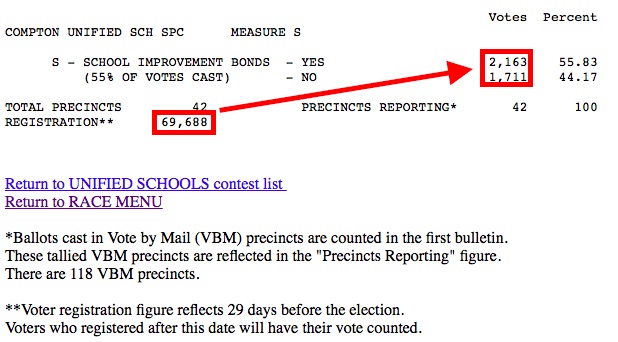Preliminary results for the November 3, 2015 elections held in some California counties indicate that voters approved eight of the nine bond measures proposed by a total of eight California school districts. Voter approval means that the districts are now authorized to borrow a specific maximum amount of money for facilities construction by selling bonds to investors. The districts will pay back the investors over time, with interest, by collecting property taxes designated to paying off the bonds.
 At this link is a chart (depicted to the right in miniature) that provides the latest preliminary data about the nine bond measures, the election results, and the current debt service from previous bond measures at the eight school districts: All California Educational Bond Measures Considered by Voters on November 3, 2015 Ranked by Percentage of Voter Approval
At this link is a chart (depicted to the right in miniature) that provides the latest preliminary data about the nine bond measures, the election results, and the current debt service from previous bond measures at the eight school districts: All California Educational Bond Measures Considered by Voters on November 3, 2015 Ranked by Percentage of Voter Approval
If election outcomes for these bond measures do not change, voters have now added another $972 million to the $146 billion previously authorized by California voters since 2001 to borrow for K-12 school and community college facilities construction. This is a minimal amount compared to the amount of potential bond authority anticipated to be on the ballot for the 2016 presidential primary and general elections.
A $208 million bond measure for the Walnut Valley Unified School District in Los Angeles County is the one failure. It is a little short of the 55% threshold needed for approval. A small but dedicated and informed opposition campaign (Real Grassroots Oh No! on “O” Movement) was able to educate district residents about the shortcomings of this proposed bond measure.
A $3.2 million bond measure for technology at the Placerville Union School District in El Dorado County is barely above the 55% threshold.
The most notable election result is at the Compton Unified School District.
Preliminary results show that the $350 million bond measure proposed by the district passed with 55.8% of the vote.
 Out of 3,874 ballots on which votes were recorded, 2,163 votes were in favor of borrowing the $350 million via bond sales for facilities construction. Los Angeles County reports that the Compton Unified School District has 69,688 registered voters.
Out of 3,874 ballots on which votes were recorded, 2,163 votes were in favor of borrowing the $350 million via bond sales for facilities construction. Los Angeles County reports that the Compton Unified School District has 69,688 registered voters.
This means that current election results for the bond measure show that 5.6% of registered voters in the district actually voted, and 3.1% of registered voters voted Yes.
The amount of money authorized for Compton Unified School District to borrow per Yes vote is $161,812. For comparison, the amount of money authorized to borrow per Yes vote for every approved bond measure from 2001 through 2014 for educational construction in California is $4,819.
Include interest to be paid over the next 40-50 years to investors on the money borrowed via bond sales, and each Yes vote was probably worth about $300,000 in debt service for Compton Unified School District.
The lack of civic participation appears even worse when all residents of the district are considered. The Compton Unified School District has a total population of about 155,000 and includes the City of Compton, portions of the cities of Paramount and Carson, and surrounding unincorporated areas of Los Angeles County. Average Daily Attendance in the district has ranged between 23,000 and 23,400 for the past few school years.
Who were the 2,163 people who voted for the bond measure? After it was fairly certain that the bond measure had passed, the International Brotherhood of Electrical Workers Local Union No. 11 based in Los Angeles used its Facebook page and Twitter account to highlight its apparently substantive Get-Out-the-Vote activities in the district to pass the bond measure.
In 2005, the Compton Unified School District board of trustees voted 3-2 to require its contractors to sign a Project Labor Agreement with construction unions as a condition of working on projects funded by a previous bond measure approved by voters in 2002. (See the Project Labor Agreement here.) Obviously unions are now anticipating that the school board will mandate another Project Labor Agreement for construction companies. It will be the reward for union campaign activism in getting this bond measure passed.
There was a small grassroots campaign opposed to the bond measure: see Vote NO on Compton School Bond – $350,000,000. News coverage of the bond measure in the Compton Business Journal was also subtly skeptical, noting that the bond measure was “controversial” and emphasizing that authorizing a bond measure means authorizing a property tax increase.
Kevin Dayton is the President & CEO of Labor Issues Solutions, LLC, and is the author of frequent postings about generally unreported California state and local policy issues at www.laborissuessolutions.com. Follow him on Twitter at @DaytonPubPolicy.

